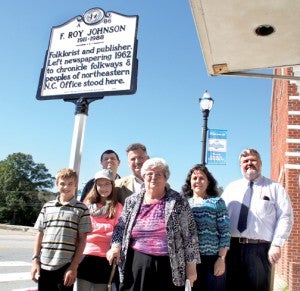The Great Storyteller
Published 9:13 am Tuesday, October 28, 2014
MURFREESBORO – F. Roy Johnson spent his adult life sharing stories.
In return, his contributions to society are now on public display.

Descendents of the late F. Roy Johnson were on hand Saturday for the unveiling of a state historic marker in downtown Murfreesboro. From left are Ben, Miranda, Roy, Neil, Mabel, Crystal and Mark Johnson. Staff Photo by Cal Bryant
Saturday morning, a North Carolina State Historical Marker was unveiled near the Elizabeth S. Parker Library on Main Street in Murfreesboro, marking the former spot where Johnson operated a print shop from where newspapers and books were published detailing the life and times of the Roanoke-Chowan area.
Johnson, a native of Bladen County, and a graduate of Duke University, began publishing the Surry County (VA) Herald in 1938 in Wakefield, VA, using the equipment at the defunct Surry Herald. The same year he also began publishing his first Murfreesboro newspaper, The Northeastern North Carolina News, from Wakefield, VA. He would drive to Murfreesboro to collect news stories, sell ads, and then return to Wakefield to print the newspapers.
In August 1940, Johnson moved with his family from Wakefield to Murfreesboro to begin publishing a local newspaper full time. His main newspaper was the Roanoke-Chowan Daily News which he published until 1962 when he sold the publishing rights to Parker Brothers Newspapers in Ahoskie.
Later in 1962, he established Johnson Publishing Company, thus beginning a book publishing career spanning 25 years. In 1963, he released his first book under the banner of Johnson Publishing Company, The Fabled Doctor Jim Jordan: A Story of Conjure. The book told the remarkable true story of James Spurgeon Jordan, a “root” doctor residing in Como. Dr. Jordan was infamous along the east coast of the United States for his unorthodox cures and remedies for all sorts of personal aliments.
Noted Hertford County historian, author and publisher E. Frank Stephenson Jr. said the state marker in Johnson’s honor was duly earned.
“We are very grateful that the state agreed to honor Roy Johnson,” Stephenson said during Saturday’s ceremony. “The legacy Roy Johnson left here is beyond comprehension. The published works he did with people of color was way ahead of its time. An example is the book he published on the famed Dr. Jordan (The Fabled Doctor Jim Jordan: A Story of Conjure). Dr. Jordan gave Roy unprecedented access to his personal life; at that time, in the early 60’s, was unheard of.
“He went on to publish two books on the Nat Turner story; those two books propelled Roy onto the national stage and added credence to his work. Folklore was what made Roy tick…he loved it,” Stephenson added.
Stephenson recalled his many visits with Johnson at his print shop in the heart of downtown Murfreesboro.
“He would tell me stories of his trips out into the country, who he had interviewed,” Stephenson shared.
Johnson’s work earned him the highest honor bestowed by the North Carolina Folklore Society and attracted the attention of the News & Observer who honored him once as Tar Heel of the Week.
Mark Johnson, who still lives on the family farm near Wakefield, VA, shared thoughts about his grandfather, first thanking those who put forth the effort to have the historic marker erected.
“His (print) shop is no longer here, but this sign is an indication that he’s still remembered,” Johnson said. “I remember the family coming here to visit. My dad (the now late F. Roy Johnson Jr.) would take me and (brother) Neil to the shop to see what grandpa was doing. It was a fascinating place.
Mark Johnson recalled that his grandfather was a bit on the shy side, but worked very well one-on-one with people.
“He went to New York and met with Chief Elton Green of the Tuscarora Tribe and the two of them put together a book on the Tuscarora language,” Mark noted. “If he hadn’t gone out and recorded the folklore of people, so much of that history would be lost. That was one of the main contributions that he made.”
“It means so much to me and my family that you have gone out and honored my granddad and his work in this way,” said Neil Johnson of Raleigh.
According to Neil, it was apparent that Roy Johnson was an entrepreneur while enrolled at Duke University.
“He had a Smith-Corona typewriter back then and would pay for his college by typing thesis papers for graduate students at 10 cents per page,” Neil recalled. “I can remember him typing on that old linotype machine in the shop here…he was pretty fast. And those presses he had in the back, they looked like locomotives to Mark and I when we were little. The gears on one press were bigger than Mark and I. We were fascinated during our visits to the shop; it was a strange and mysterious place. We’d poke around while granddaddy worked.”
Roy Johnson got out of the newspaper business in the 1960’s, but his career was far from over.
“He really wanted to pursue his love of folklore and history,” Neil stated. “He never slowed down until the year before his death (1988). I counted over 40 books that he either authored, published or both.”
Another thing that stuck out in Neil’s mind was his grandfather’s hands.
“They were always stained with printer’s ink; his clothes had ink spots,” he said. “The front door was always open and people would come in. That was never a distraction for granddaddy, he loved to talk to them, hear a story or share a story.”
Neil marveled at the way his grandfather would publish a book or newspaper, singlehandedly. Typing the copy on an old-fashioned linotype machine, using a letter press to transfer the type to paper, exposure a sheet of film of each page, burn the plates, place the plates on the press, and then bind all those pages together.
“My granddaddy was never afraid of work and now that I’m older I can see and understand the full value of his work. Thank you so much for remembering him through this memorial,” Neil concluded.
Other books published by Johnson include The Peanut Story, Tales From Old Carolina, Legends and Myths of North Carolina’s Roanoke-Chowan Area, Witches and Demons, The Old South With Brer Rabbit and His Neighbors, The Algonquians, The Gatling Gun and Flying Machine (with Frank Stephenson), North Carolina Indian Legends, and The Lost Colony in Fact and Legend (with Thomas C. Parramore).
Johnson died at his home in Murfreesboro on Oct. 17, 1988. Lengthy notices of his death were carried widely by numerous newspapers and news outlets. He is buried in Riverside Cemetery in Murfreesboro.



